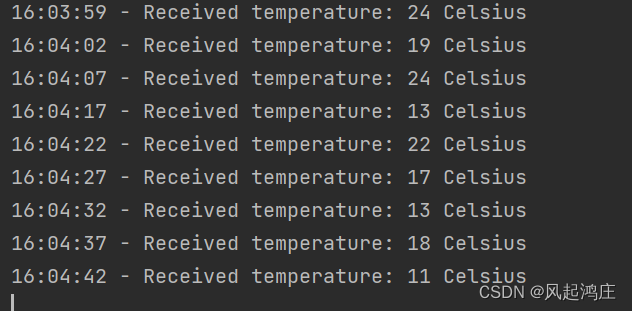Python访问OPCUA服务器,订阅一个变量标签
1 2 3 4 5 6 7 8 9 10 11 12 13 14 15 16 17 18 19 20 21 22 23 24 25 26 27 | from opcua import Clientfrom opcua import uaimport time#By Weloveut:Python访问OPCUA服务器,展示get变量的方法和注册逢变触发的回调函数#自定义回调函数class SubHandler(object): def data_change(self, handle, node, val, attr): print("Python: New data change event", handle, node, val, attr)#创建UA的客户端,包含IP地址和端口号client = Client("opc.tcp://172.32.1.82:4840/")#建立到服务器连接client.connect()#获取object对象objects = client.get_objects_node()#获取根对象root = client.get_root_node()#依据变量地址创建变量对象myvar = client.get_node('ns=3;s="clocl0.5hz"."tags"[0]')#获取变量当前值valuetmp=myvar.get_value()print(valuetmp)#注册到服务器的变量订阅,变量逢变触发handler = SubHandler()sub = client.create_subscription(500, handler)sub.subscribe_data_change(myvar)time.sleep(100000)client.disconnect() |
opcua-python学习踩坑记录
OPCUA通信协议介绍
OPC UA(OPC 统一架构)是一种用于工业控制系统的通信协议。它是一种开放的、平台无关的协议,可用于连接各种工业设备和软件应用程序,使它们能够互相通信并共享数据。
OPC UA 的主要优点在于,它能够提供一种统一的方式来连接不同厂商的设备和应用程序。这意味着,使用 OPC UA 的软件应用程序可以与使用其他协议的设备和应用程序进行通信,而无需考虑底层的通信协议。
其实这类似于物联网中的mqtt协议,只不过mqtt较为轻量级,opcua则是用于工业相关的控制系统
OPCUA的两种工作方式
- 客户端/服务器模式:在这种模式下,OPC UA 客户端向 OPC UA 服务器请求数据,服务器接收请求并向客户端发送数据。
- 发布/订阅模式:在这种模式下,OPC UA 服务器将数据“发布”到网络上,而客户端可以“订阅”特定的数据。当服务器更新数据时,客户端会收到更新的数据。
这两种模式可以根据应用场景的需要进行选择。例如,客户端/服务器模式适用于客户端需要向服务器请求单个数据项的情况,而发布/订阅模式则适用于客户端需要定期接收大量数据的情况。
个人觉得客户端/服务器模式类似于TCP通讯协议,是点对点的,对实时性要求比较高,而发布订阅模式类似于UDP通讯协议,对实时性要求并没有那么高,但接收数据较多
其中发布订阅模式对小的嵌入式设备(stm32系列)比较友好,可以融合物联网的mqtt协议,真正将opcua纳入网络,而不只是自己的工业网络
OPCUA-python是什么?
顾名思义,那就是利用python实现这种通信协议的库呗,这个库目前已经停止更新,开发者们开发了一个新的库,名为opcua-asyncio,可通过如下链接访问:
https://github.com/FreeOpcUa/opcua-asyncio
不过做一些比较基本的功能,只用OPCUA-python这个库还是够用的
服务器常用函数
1 2 | endpoint = "opc.tcp://{}:{}".format(url, port)myserver.set_endpoint(endpoint) |
设置endpoint(其实endpoint就像一个服务器链接)
1 | myserver = opcua.Server() |
开启opcua服务器
1 | objects = myserver.get_objects_node() |
设置服务器节点(使客户端得以访问)
1 | addspace = myserver.register_namespace(name) |
设置服务器命名空间
1 | root = myserver.get_root_node() |
获取服务器根节点
1 | objects.add_method(1, "Conveyor", Start_Conveyor_prog) |
为节点(objects) 添加方法Start_Conveyor_prog
客户端常用函数
1 | myclient = Client(endpoint) |
在客户端引用endpoint
1 | myclient.get_node("ns=2;i=3") |
在客户端里使用ns=2;i=3这个节点
1 | Start_Lathe_Prog1 = method[4] |
调用服务器里设置的方法
1 | Workpiece = objects_node.call_method(Start_Conveyor_prog,[WorkpieceID.get_value()]) |
call_method函数,第一个参数是节点名称,第二个参数是值,是这个节点里的值,属于数组,或者传递字典也是可以的
1 | return_value_kuka_prog1 = objects_node.call_method(Start_Kuka_Prog1) |
返回某个方法
示例程序:温度实时检测,每隔五秒传到客户端
服务器程序:
1 2 3 4 5 6 7 8 9 10 11 12 13 14 15 16 17 18 19 20 21 22 23 24 25 26 27 28 29 30 31 32 33 34 35 36 37 38 39 40 41 42 43 44 45 46 47 48 49 50 51 52 53 54 55 56 57 58 59 60 61 62 63 64 65 66 67 68 69 70 71 72 73 | import opcuafrom time import sleepfrom random import randintfrom datetime import datetime # Assign endpoint URLurl = "localhost"port = 5001endpoint = "opc.tcp://{}:{}".format(url, port) # create instance/object of type opcua.Servermyserver = opcua.Server() # Assign endpoint url on the OPC UA server address spacemyserver.set_endpoint(endpoint) # Create a name for OPC UA namespacename = "Temperature Sensor" # Register the name on OPC UA namespaceaddspace = myserver.register_namespace(name) # Get reference to the Objects node of the OPC UA serverobjects = myserver.get_objects_node() # Create objects on the object nodeparam = objects.add_object(addspace, "parameters") # Create variablesSensor_name = param.add_variable(addspace, "Sensor Name", "Temperature_Sensor_SF12")Temperature = param.add_variable(addspace, "Temperature Value", 'NA') # Set variable as writableSensor_name.set_writable()Temperature.set_writable() ########################################################################################## Present the data structure of the OPC UA serverroot = myserver.get_root_node()print("Root Node Id: %s" % root)print("Children of root are: %s" % root.get_children())print() my_objects = myserver.get_objects_node()print("Defined object Node Id: %s" % my_objects)print("Children of the defined object are: %s" % my_objects.get_children())print() sensor_name_node = my_objects.get_children()[1].get_children()[0]print("Sensor name node Id: %s" % sensor_name_node)print("Sensor name node browse name: %s" % sensor_name_node.get_browse_name())print("Sensor name default value: %s" % sensor_name_node.get_value())print() temperature_node = my_objects.get_children()[1].get_children()[1]print("Temperature node Id: %s" % temperature_node)print("Temperature node browse name: %s" % temperature_node.get_browse_name())print("Temperature default value: %s" % temperature_node.get_value())print()######################################################################################## # starting! The server will continue runningmyserver.start()current_time = str(datetime.now().time())[:-7]print("{} - Server is initialising...".format(current_time)) while True: sleep(5) current_time = str(datetime.now().time())[:-7] current_temp = randint(10, 25) Temperature.set_value(current_temp) # publish temperature value print("{} - Current temperature: {} Celsius".format(current_time, current_temp)) |
客户端程序:
1 2 3 4 5 6 7 8 9 10 11 12 13 14 15 16 17 18 19 20 21 22 23 24 25 26 27 28 29 30 31 32 33 34 35 36 37 38 39 40 41 42 43 44 45 46 | from opcua import Clientfrom datetime import datetime # Assign endpoint URLurl = "localhost"port = 5001endpoint = "opc.tcp://{}:{}".format(url, port) # Assign endpoint url on the OPC UA client address spacemyclient = Client(endpoint) # Connect to servermyclient.connect() # Assign nodesTemperature_node = myclient.get_node("ns=2;i=3") # Subhandler Class from OPC UAclass SubHandler(object): """ Subscription Handler. To receive events from server for a subscription """ def datachange_notification(self, node, val, data): """ called for every datachange notification from server """ global DataChange # Global variable current_time = str(datetime.now().time())[:-7] DataChange = val # Assigning value to global variable print("{} - Received temperature: {} Celsius".format(current_time, val)) # Initailise variable nodes = myclient.get_objects_node()DataChange = "null" # Create Sub handlerhandler = SubHandler() # create subscription by passing period in milliseconds and handlersubscribe = myclient.create_subscription(0, handler) # pass variable node to subscribe data change methodhandler = subscribe.subscribe_data_change(Temperature_node) |
程序运行效果:服务器

程序运行效果:客户端

总结
以上为个人经验,希望能给大家一个参考,也希望大家多多支持IT俱乐部。

